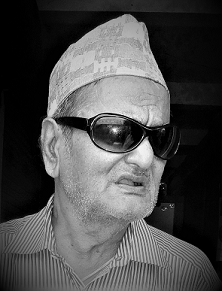Balkrishna Pokharel’s Native Tongue
Dr. Nawa Raj Subba.
The Khas language of Nepal is called the Nepali language. This language is the contact language of Nepal. This language, which sounds like Hindi, is also called the hilly Hindi language by some people. In this way, some linguists of Nepal did not like to call the Nepali language a mountain Hindi language. They knew that Sanskrit, Urdu, Hindi, Nepali Khas, etc., belong to the Indo-European language family. Even though India and Nepal are culturally similar, they are different countries today. Similarly, although Nepali Khas and Hindi belong to the same language family, the opinion was born that the Nepali language should not be called the hilly Hindi.
Native tongues merged with the Khas and became different from previously during the establishment of Nepal, along with the spread of the Nepali Khas language. The Khasa language is comprised of simple Jharra terms. Therefore, Nepali linguists felt that the Nepali Khas language has a lot of originality even though it sounds like Hindi when spoken or heard. Thus, a national opinion formed that the Nepali language should no longer be called Pahari Hindi, i.e., the sister of Hindi, the Nepali Jharrobadi language movement. Balkrishna Pokharel is one of the leading activists of the Jharrowist language movement.
He was born on the 13th of Bhadra in Vikram Sambat 1990 in Chisapani Gadhi of Makwanpur. His father’s name is Subba Sharda Pokharel, and his mother’s name is Chayadevi Pokharel. He was educated at Banaras Hindu University and Calcutta University. After education, he made a notable contribution to linguistics. His major works include History of Khas Jatilo Itihas, 100 Years, and the Nepali Dictionary. In addition, he has written many books such as novels, poems, stories, essays, etc. He taught at Tribhuvan University for a long time. He is known as Professor Balkrishna Pokharel in the Nepali language. He died on 12th Falgun 2075 at the age of 86 in Biratnagar.
Today the linguist Pokharel is not in this material world. However, he is in our hearts. Therefore, I want to put the events of a few months before his death here in a memoir style. It was probably his last literary program organized by himself. This article is a sketch of a literary event held in Biratnagar. I am sharing this note because I have learned some notable things in the Nepali language and literature. This educational event was held in Biratnagar on May 26, 2018.
The ‘Rupatreya Wangmay Pratishthan’ established by Linguist Prof. Balkrishna Pokharel distributed the ‘Rupatreya Shanta Award’ in 2075. There was a provision to provide a certificate and Rs 30,111 cash to one language worker. Chudamani Regmi was the writer who received that award. Regmi is known as Motiram of Eastern Nepal. He is also another activist of the Jharrobadi movement. Critic Dadhiraj Subedi said in a talk that Balkrishna Guru greatly desired to honour Chudamani Regmi before he died. I thought that what he did was well done. I also went to the program as an invitee of Guru.
During the speech at the award ceremony, the linguist Pokharel addressed the awardee Regmi as a ‘traveller of work and duty. Linguist Pokharel remembered Regmi’s ancestral days and became emotional. He claimed that Regmis’ grandfather, his father, used to live in Biratnagar and held Subba and Ditta positions in the past. His family was having a good time in Biratnagar on beautiful land. So why did Regmi suddenly abandon Biratnagar and make Jhapa his work base? Balkrishna Guru himself satisfied himself. Anyway, Regmi went to Jhapa and made the whole environment there literary. So Regmi has made an outstanding contribution to the academic development of Jhapa today.
At the same time, Prof. Kaviraj Neupane also commented on Regmi’s contribution. Regmi not only served literature by writing dozens of books but also edited dozens of works and introduced many authors to the readers. Regmi searched for a new creator and brought it to light. He refined the creator. That is why he is called the Motiram of the East. Critic Dadhiraj Subedi also presented a comprehensive summary of Regmi’s entire work.
After his turn, Chudamani Regmi made an exact comment about the Jharrobadi movement. During his remarks, he informed that he is not the leader of this movement but only a worker who follows behind the leader. He was speaking as one of the witnesses of Balkrishna Pokharel, Koshraj Regmi, Ballavmani Dahal, and Taranath Sharma, the leaders of the Jharrobadi movement. Regmi remembered the past. He compared Balkrishna Pokharel, Koshraj Regmi, Ballavmani Dahal, and Taranath Sharma of the Jharrobadi action to Marx, Engels, Lenin, and Stalin, the charioteers of the world communist movement.
Chudamani Regmi clarified the point; many writers put the names of Balkrishna Pokharel and Taranath Sharma before or after them in the Jharrobadi movement; he recalls seeing that most of them put Taranath Sharma as number one. Taranath Sharma’s intelligence, he believed, had inspired the reader to do so. Taranath Sharma is an activist who joined the Jharrobadi movement only a little later. Taranath Sharma came later to join the campaign raised by Balkrishna Pokharel and others in the Jharrobadi action. So Chudamani Regmi addressed Balkrishna Pokharel as ‘Shiromani’ head of the Jharrovian movement. We learned that day that Balkrishna Pokharel had been a number one player in the Jharrovadi movement.
It was the turn of linguist Tank Neupane to speak. Giving this ‘Rupatreya Shanta Puraskar’ to Chudamani Regmi is to honour the role played by Regmi in the Jharrovian movement. Another Prof., Gopal Bhandari, spoke in the Nepali language about the justification of the Jharro movement and the importance of the Nepali language. He expressed concern that the Nepali language has been reduced in the higher secondary level course. Bhandari insisted that although the critics of Jharroism try to make light of it as a Jhalluvaist movement, it has become more watery. Intellectual personality NP Sharma said during the speech that there is a need for a new version of Jharroism. Listening to the scholars, it became clear that the importance of Jharroism did not decrease but increased.
After returning from the ceremony, I learned the topic in detail. Let’s see what the prevailing beliefs about language in Nepal are. In the development of the Nepali language, there are two concepts of the Nepali language. First, when it comes from Sanskrit to Nepali, there is nothing special about it. The Indo-European family has Hindi and Urdu languages within the Indo-Arya family. Those languages are branches of the Sanskrit language. This concept also considers the Nepali Khasa language as a branch of the Sanskrit language. According to the second concept related to language, the Nepali language developed from Prakrit, Sanskrit, and Khas, Parvate. During its evolution, this Nepali language has got many peculiarities grew. This second concept seems to have been strengthened by the Jharrobad/Jharroism.
I also read critical concepts and facts about linguistics in culture and anthropology. Indian linguists have outlined the origin of Hindi, Urdu, and Nepali languages. According to the linguist Pandeyan, the Nepali language has become the Nepali language through Prakrit, Pali, Sanskrit, Khas, and Parvate within the Indo-European language family.
Scholars do not consider Sanskrit only as a language. This language is the vocabulary of the thoughts and culture of the wider community. Analyzing the different words found in the Sanskrit language, we see the tribal Lepcha vocabulary, scholars claim (Indian Inspires). According to this scholar, the word Baraha in Sanskrit may have been derived from Saraha in the Kirat Limbu language (Subba). There is no doubt that the Devanagari script developed from the Brahmi script.
On this basis of linguistics, the source of the Nepali language cannot be considered only Sanskrit or Hindi. The statement that Nepali is a branch of Sanskrit or Hindi is misleading. Because within the Sanskrit language are countless native words of tribal Dravidians and Kirats. Linguists believe in a profound influence of Dravidian/Tamil tribal languages on the Sanskrit language (History Hindi; Pandian; Logan). Linguists and researchers agree that Sanskrit was constructed with the help of Dravidian, Tamil, and other native languages spoken by Saptasindhu tribals (Pandian; Daniel Gabin).
The Sanskrit words ‘Sama’ and ‘Krit’ combine two words. ‘Sam’ means all languages , and ‘Krit’ means the language made up, indicating a Sanskrit derivation (Indian Inspires). Thus, it is clear from the semantics of the Sanskrit word itself that it comprises different languages. This is said in Rigveda in the question of what Sanskrit is (Rigveda). Therefore, the creation and development of the Sanskrit language are based on Prakrit, Pali and tribal Kirat, Dravidian languages , etc. (History Hindi; Pandian; Logan).
According to linguist Balkrishna Pokharel, Kirat and Khas used to have blood, geographical and cultural unity. There was a closeness between them for a long time. During their separation, the Khas group moved to the Himalayas and developed the Nepali language (Pokharel). We know this as the Khas Parbate Nepali language. Today it has become a national language and contact language of Nepal.
Shreds of evidence suggest that the Nepali language is developed through Prakrit, Pali, Sanskrit, Khas, and Parvate languages within the Indo-European language family. The relation of the Nepali language is not only limited to Sanskrit and Hindi.
Thus, the Nepali language is not a branch of Sanskrit or Hindi. Although it belongs to the Indo-Arya language family, the background of the development of the Khas language is unique. That is the crux of Jharroism/Jharrobad.
References
Danielou & Gabin (2003). “Shiva and the Primordial Tradition: From the Trans to the Science of Dream. Inner Traditions”, Rochester, Vermont 05767. 2003.
History in Hindi. “Harappan Civilization Mohenjo Daro Indian Tribe in India. History in Hindi”. [Video], 2020, August 29, 2020. https://youtu.be/17Xzy612kBA
India Inspires. “Myths about Sanskrit” [Video file]. Accessed July 24, 2014. https://youtu.be/2O4oaDaO36Y
Logan, James Richardson. “General Characters of the Burma-Tibetan, Gangetic, and Dravidian Languages”. The Journal of the Indian Archipelago and Eastern Asia. Volume 7, January 1853, pp105-137.
Pandian, Arjunan. “Ancient Indian Religion Part 4. Ancient India” APN. 2019
Pokhrel, BalKrishna, “Khas Jatiko Itihas,” Udatta Anusandhan, Biratnagar, 2055.
Rigved, “Rigved Hindi Bhasya,” Arya Samaj Sthapana Satabdi Prakashan, New Delhi, Samvat 1934.
Subba, Nawa Raj, “Kirat Limbu Sanskriti Manavsastriya Bivechana” Kathmandu, Ajambari, 2078.


